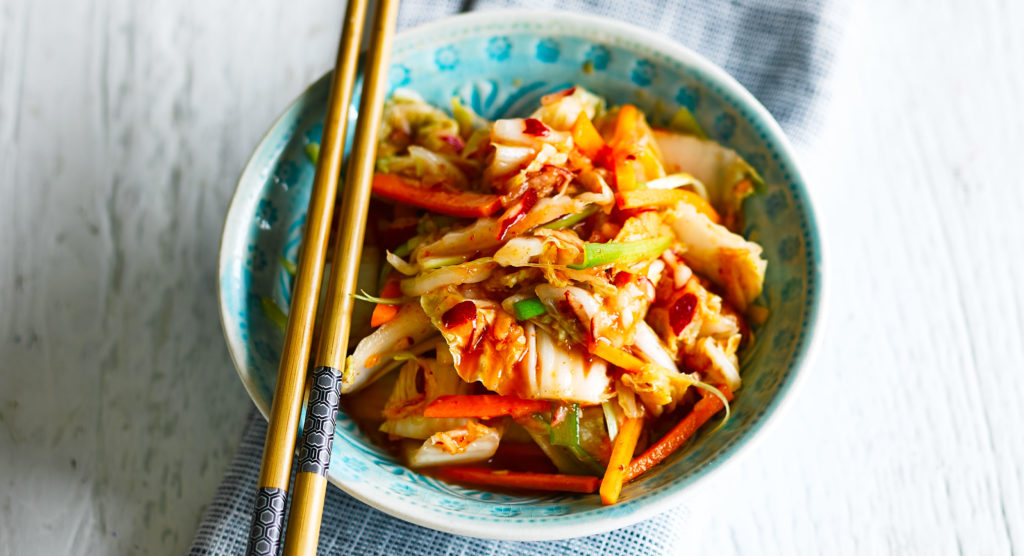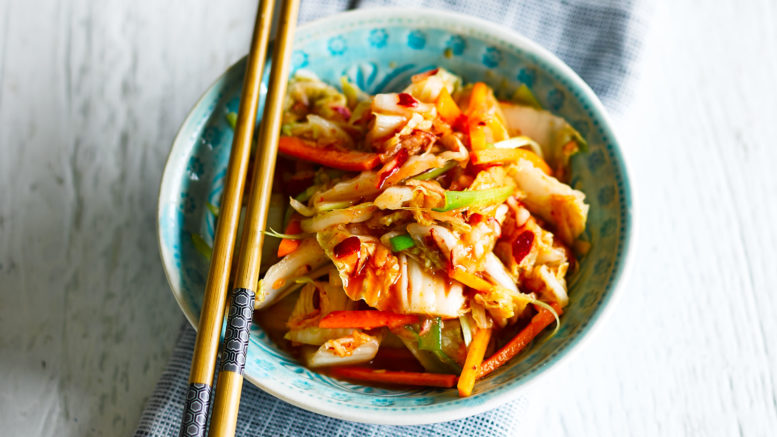
Pronounce it: Kym-chee
Kimchi is a Korean family of well over 100 different vegetable pickles eaten as a side dish, a wrap and as a condiment. It is the most famous Korean dish, made and eaten in both North and South Korea, and increasingly popular in the West.
Each kimchi pickle is produced by lactic fermentation in brine in the same way as sauerkraut and pickled cucumber. By far the most popular and the best-known kimchi in the West is pickled cabbage and the Korean version is identified by the common addition of fish sauce (made from fermented shrimp and other fish) or dried shrimps, both of which give an extra characteristic smell and taste that is addictive to some, abhorrent to others. Since the 16th century kimchi has also included chillies introduced from South America, sometimes in fiery amounts, but this is not essential. Ginger root, daikon radish, carrot, garlic, herbs and spices might also be added.
Kimchi is proven to have outstanding nutritional benefits. Its high content of the umami taste is associated with an enhanced feeling of well being, just as any high chilli content creates serotonins to compensate for the burning of the palate, an opiate-like effect, which is truly addictive. It is these two effects that lead to verifiable stories of Korean soldiers refusing to serve unless guaranteed supplies of kimchi.
Read our guide on the health benefits of fermenting.
Availability
Increasingly available in Asian supermarkets and online. There are many printed and online recipes for making your own.
Choose the best
This is strictly according to personal taste, based on ingredients and length of fermentation. A small degree of fuzzy white mould is associated with the fermentation process and not harmful but if mould persists and is excessive and discoloured, accompanied by a strong, unpleasant smell, it is likely something’s wrong. Fermented food is generally very safe but, if in doubt, throw it out.
Store it
Kimchi must be kept cool, which is why it is traditionally best made late autumn or in winter; many modern Koreans have dedicated kimchi refrigerators. Provided it is made, bought and stored with care, kimchi will last a long time, although there will be an increase in flavours and smells.
Cook it
Kimchi is basically salty and acidic and is thus ideal as a foil to rich dishes. It is commonly sliced and added to soups and hotpots or chopped to be stirred through rice. A whole leaf can be used as a wrap for meat, fish or shellfish. Most often it is sliced and enjoyed as a piquant side dish.
If you make your own cabbage kimchi, choose recipes that use quartered or large pieces of cabbage rather than slices, as these give more predictable results. The correct cabbage is the napa variety, commonly known as Chinese cabbage; it’s a pale, tightly packed long shape with wide white stems, and it’s this variety that brings such broad nutrition to kimchi. It’s widely considered polite to serve kimchi in whole pieces and to slice them at table, proving you are not offering leftovers. To keep the kimchi uncontaminated with foreign bacteria and off-flavours, always use very clean utensils to take it from the pickling liquid.
A two-week fermentation is considered a minimum and retains some of the freshness of the cabbage – but it can be months old and will then be increasingly noisome and challenging to some, even more delicious to others.
Pioneering BBC-TV Chef Glynn Christian is author of REAL FLAVOURS – the Handbook of Gourmet and Deli Ingredients, voted ‘World’s Best Food Guide’.

Be the first to comment on "Kimchi"